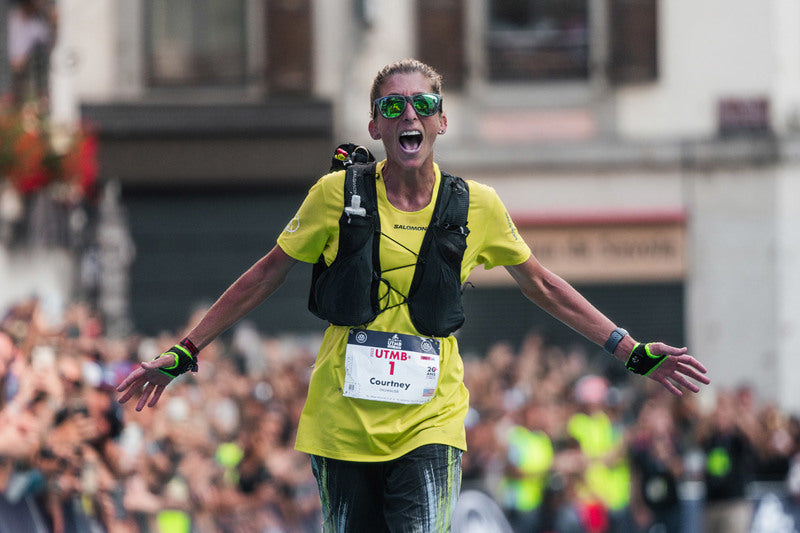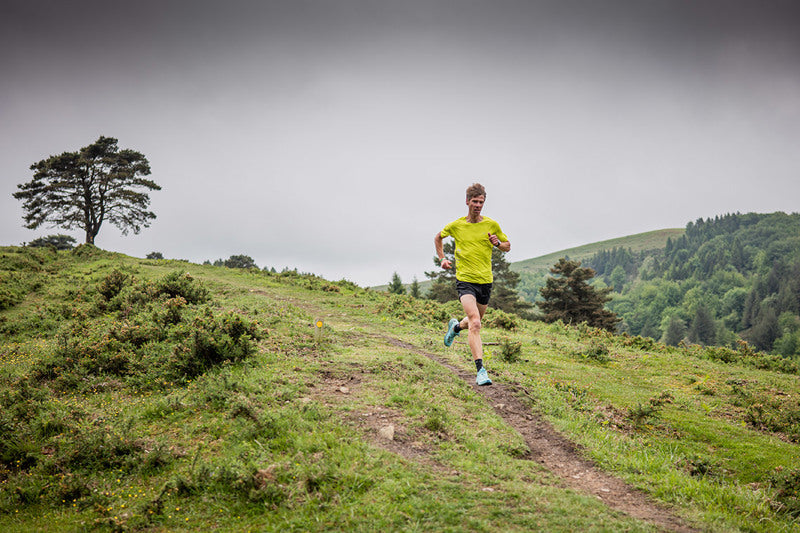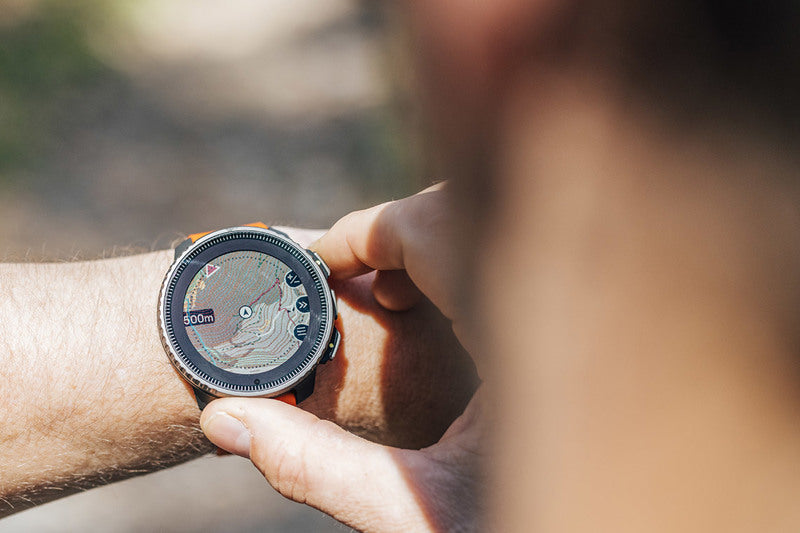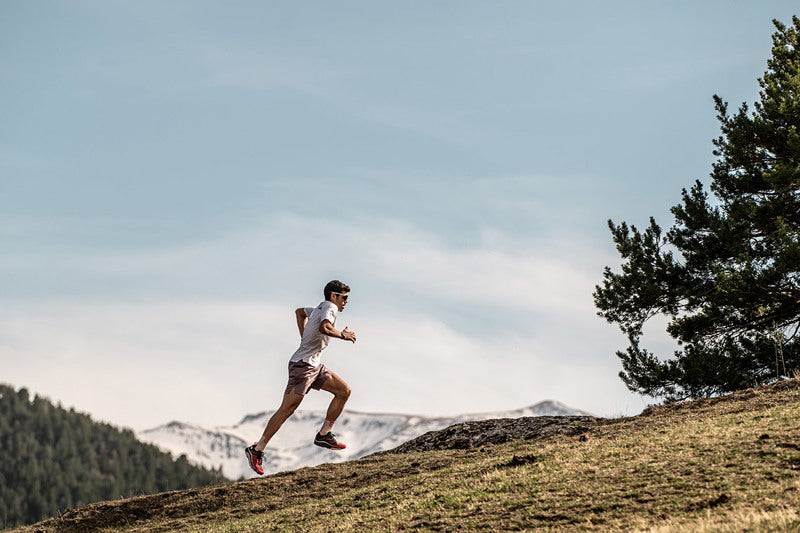

Suunto Blog

Courtney Dauwalter makes history at the UTMB
Suunto ambassador Courtney Dauwalter wins the UTMB® and completes her "Triple Crown Challenge".
Suunto ambassador Courtney Dauwalter became the first person ever to win the three legendary 100-mile ultra-trail running races, UTMB, Western States Endurance Run and Hardrock 100 in the same year. And not only in the same calendar year but within just two and a half months.
Courtney’s UTMB win also completed her UTMB hat trick. Saturday’s win was her third in the 170 km race around Mont-Blanc. Her previous wins were from 2019 and 2021.
“I think anytime we are given the opportunity to try something difficult or crazy we should absolutely take it. This was totally crazy and really, really difficult – but worth it,” Courtney said at the finish line, only moments after completing her unbelievable feat.
Courtney approached all three of the races as if each was the only race of her season. She didn’t think of the fatigue there might be and was giving it all that she had in each of them. Her tactic paid off as she set new course records at the Western States in California in late June as well as at Hardrock 100 in Colorado in July.
Courtney started the UTMB with that same intention; without being conservative with pacing.
“Let’s race how I normally would and see where that road leads us,” she thought.
It seems that her tactic worked out – until about two-thirds of the way. On top of one of the biggest climbs, the Grand Col Ferret, total body fatigue hit.
“The entire second half of the race was really, really hard. My body was not wanting to run anymore. My stomach was a little finicky. I almost lost my lunch on the streets of Champex Lac but luckily held it together and was able to will myself to this finish line.”
“Honestly I am not sure if I would have made it back here without Kevin, my husband, and some of my family crewing and all the insane fans out on the course. Thank you so much! That was one of the coolest things I have ever experienced! And the volunteers were just the best. Thank you all for helping me get back to Chamonix.”
The UTMB starts in Chamonix, France and circumnavigates the tallest mountain in Europe through Italy and Switzerland to finish again in Chamonix amongst the passionate trail-running crowd.
Courtney finished her race in 23 hours, 29 minutes and 14 seconds. The second female finisher, Katharina Hartmuth stopped the race clock – as well as her Suunto Vertical – in a time of 24:10:52.
Courtney ran the race with her trusty Suunto 9 Peak Pro. She likes the lightweight and compact design of the Suunto 9 Peak Pro. Despite the smaller form factor and 55-gram weight, the Suunto 9 Peak Pro has a 40-hour battery life with best GPS settings, great accuracy and all the features Courtney needed to make ultra-trail history – again.
All images by The Adventure Bakery
READ MORE
Ultra champ Courtney Dauwalter’s 6 tips for mental strength
Courtney Dauwalter and her pursuit of mind power
Be my adventure valentine: what you need to know to be the ultimate support person

Chase Strava segments with Suunto
Segments are a key part of the Strava community for many. They are stretches of road or trail created by members where athletes can compare times. The segments can be used to compete with others or to follow your own progress over time.
A great example of the power of Strava Segments can be found in Suunto ambassador Philipp Reiter’s home village of Bad Reichenhall in Southern Germany. “The trail up Dötzenkopf is a steep 1,8 km uphill with 400 meters of elevation gain”, says Suunto ambassador Philipp Reiter. “It’s my favorite training area and I have been up there more than 1500 times. From the top you have a nice view over Bad Reichenhall and to Salzburg.”
The power of the trail and the segment is more than the physical challenge of it: it brings people together. “People do it for fitness before and after work, the older people in the morning. During Easter and Christmas, they prepare a little tree and hang decoration. It’s also a social meeting mountain for the locals,” says Philipp.
Strava Live Segments bring the experience of competing on a run or ride segment to your Suunto Vertical, Suunto 9 Peak Pro, Suunto 9 Peak and Suunto 9 Baro watch.
Here’s step by step guidance on how to use the feature.
Connect your Suunto and Strava accounts
Go to your profile in Suunto app and select “Partner services” -> “Connect with Strava”.
Note: If your Suunto and Strava accounts are already connected, you will need to re establish the connection to get the segment data to flow from Strava to your Suunto account: Simply go to the above mentioned "Partner services" section of Suunto app, find "Strava" and tap "disconnect" and then "Connect with Strava" to re-establish the connection.
Select your favorite segments
On the Strava app, go to the Maps tab to find the segments you want to follow on your watch, then hit the star to save it as your favorite. The starred segments will be available for you as live segments on your Suunto. Unstarring a segment in Strava will also remove it from your Suunto.
See your starred segments in Suunto app
In the Suunto app you will see your starred segments, the ones that are synced with your Suunto for live-follow-up: Go to “SuuntoPlus Store” -> “My SuuntoPlus Guides” -> “Strava segments”
Activate Strava Live Segments on your watch
Select Strava Segments Guide for running or cycling in the exercise settings: After selecting your preferred sport mode – but before pressing start – scroll down to “SuuntoPlus” -> “Guides” -> “Strava segments”. Turn them on.
Follow segment data during activity
Strava Live Segments will be added as an extra screen. Scroll right to see it. During your run or ride, you will see how close the closest segment start is. Once you get within 100 meters, the watch will alert you that you are approaching a segment. As you reach the starting point, the segment will start.
During the segment your time will be compared to your personal record (PR), showing you how much ahead or behind you are. If you don’t have a personal best time on that segment, the comparison will be with King/Queen of the Mountain (KOM/QOM). After finishing the segment you will see your segment time, a comparison to your previous PR and whether you managed to earn the new Queen or King of the Mountain crown or not.
See the segments as laps in Suunto app
After chasing segments with SuuntoPlus Strava Segments and syncing your data with Suunto app, you can see the segments as laps in your activity.
Get Strava Subscription with a new Suunto watch
When buying a new Suunto watch you will also receive the Suunto Value Pack, a collection of benefits and treats offered by our partners. One of the benefits is a free, 60-day Strava subscription!
Learn more about Suunto Value Pack

Making outdoor spaces more inclusive
This Pride Month, we are calling all LGBTQIA+ trail runners to participate in the 2nd Annual LGBTQ+ Running Retreat in the North Cascades this October, hosted by Queer Pro Ultra-Runner, Suunto ambassador Ryan Montgomery and Aspire Adventure Running!
Ryan having a blast at the Javelina Jundred 100-miler. (Image by Nick Danielson)
”A couple of years ago when I started becoming more visible as a queer-identifying elite athlete, I recognized that the opportunity to compete at an elite level also comes with the opportunity to make an inclusive impact in the sport,” says Ryan.
“Running has been my conduit and my catalyst for really helping me understand who I am — to come out of my own closet and to be comfortable with my own identity. Part of the genesis of the Out Trails LGBTQ+ Running Retreat is to help other queer-identifying athletes have an opportunity to push themselves physically and mentally, alongside a supportive community, to learn something new about the outdoors or themselves.”
All experience levels are welcome
The LGBTQ+ Running Retreat is inviting 40 runners to Mt. Baker Ski Area, Washington, USA for 3 nights and 2 full days of running/hiking. If you are a member of the LGBTQ+ running community, we encourage you to sign-up for the running retreat now!
And to help eliminate the barrier for some members of the LGBTQ+ community, this Pride Month, Suunto is supporting the event with scholarships for 25 LGBTQ-identifying runners! Also the scholarship applications are now open.
Register for the running retreat here, or apply for the scholarship here!
To learn more about the trip, visit the Out Trails LGBTQ+ Running Retreat Course Page.
READ MORE
The importance of diversity in the outdoors
Allyship in the outdoors: what is it and how to be a good ally for others?
A native runner's perspective on inclusivity

Weekend Adventures around major European cities
This summer, we want to inspire you to take a new, unknown route and have built Weekend Adventure route collections around major European hubs.
We kicked off in June with gravel adventures around Munich and Paris and hiking adventures around Milan and our hometown of Helsinki. For July we have added four more exciting route collections: hikes in Madrid and Berlin and gravel rides in London and Rome! Most routes are within an hour from the city centre and long enough to be split into two day adventures.
Adventuring close to home is not only practical and time-efficient; it’s also good for the environment. You don’t always need to travel far to experience something new. So, pack your tent, get your gear and start exploring – the adventure starts here!
Scroll down for hikes in Berlin, Helsinki, Madrid and Milan or gravel bike rides in London, Munich, Paris and Rome!
Connect with Komoot to get the Weekend Adventure routes on your Suunto
The Weekend Adventure collections are hosted by our partner Komoot. Komoot is a platform that lets you find, plan, and share adventures. Personalized route recommendations and inspiration are in the core of Komoot.
Suunto is fully compatible with Komoot: Once you have connected the two accounts (go to Suunto app’s “Partner services” section and select “Connect with Komoot”) routes planned with Komoot flow automatically to your Suunto app’s route library and your activities tracked with Suunto go to Komoot. Turn-by-turn guidance and all is included in the sync. Learn more about the various Komoot packages
Find tranquility on these hikes in Berlin
Just a few kilometres beyond Berlin's city limits, you'll find tranquillity, magnificent landscapes, sparkling lakes and rivers, but also some thrills. In this Collection, we present three hiking Tours that take you to three regions around Berlin. You'll hike along clear waters, discover mystical wetlands and unique, mangrove-like forests. The Tours all have one thing in common: water plays a major role. Two of the hikes can be completed in a day, an overnight stay is recommended for the third one.
Enjoy the English countryside on a gravel bike
You don’t need to live in the countryside to find fantastic gravel trails. London has a vast network of off-road cycling, with some excellent tracks radiating from the city and transporting you to the serene landscapes of the home counties.
The three tours in the London collection can be covered in a day or two: All of them include a convenient midpoint accommodation option, allowing you the flexibility to extend the adventure over two days if desired.
Hike in vast forests less than an hour north of Madrid
The hiking routes in Madrid take you to the Sierra de Guadarrama National Park and the Sierra Norte region less than an hour north of the city. The area boasts vast expanses of lush forests, fantastic granite formations, mountains that tower over 2,000 metres, important rivers, and impressive limestone ravines.
You can complete all the routes in a day if you wish. Otherwise, you can also spread the distance over two days and stay halfway at a refuge or hostel. We’ve included more information in each route description.
Ride ancient roads in Rome
The gravel cycling routes around Rome venture through the Italian countryside and take you on compacted dirt tracks, ancient paved roads, fast singletrack, and rolling lanes with little traffic. Discover the woods around Lake Bracciano, trace historic routes like the Via Appia Antica, explore the wonders of the Castelli Romani, and pedal along the Regina Ciclarum – the most beautiful cycle path in Lazio – until you reach the seafront and the pine forests of the Roman coast.
These Tours are real adventures that require decent fitness and plenty of determination to complete in a day – the distances are between 97 and 179 km. You can also take it easy and split the route so you have more time to fully enjoy these rich natural and historic places.
Gravel rides just outside of Munich
Get out of the city, leave your stressful week in the city behind with only a few pedal strokes and start your weekend adventure in nature. The green surroundings of Munich are diverse – you circle crystal-clear lakes, dive into bubbling river valleys, enjoy Bavarian country life or taste the specialties of Salzburg.
Best of all: A large part of these three journeys take you away from the paved roads on fine gravel paths or exciting single tracks.
Mountain hikes close to Milan
In this Collection we offer you three truly epic hiking adventures a stone's throw from Milan. Just head north by train or car to quickly reach the foot of the mountains – and what mountains!
These three treks are as spectacular as they are demanding. They will take you to some of the most beautiful places outside of Lecco, close to Lake Como. In each tour we point out refuges or other accommodations where you can stop to eat or spend the night, as well as options to shorten the route, if you wish.
Explore Paris on a gravel bike
In this Collection, you discover the surroundings of Paris in adventure mode. The surroundings of the French capital offer a superb playground for gravel cyclists – this Weekend Adventures Collection is a proof of that!
These three cycling routes are rather long, but you can split them in two stages. Two of them make a loop and one is a point to point. However, that is not an issue as you can get back by train.
Hike in the national parks just outside of Helsinki
Our Helsinki Weekend Adventure Collection features three beautiful hikes accessible from the city. It doesn’t take long to escape the buzz of the city and find yourself immersed in archetypal Finnish landscapes, where the right to roam enables you to explore freely.
Two of the hikes explore parts of the spellbinding Nuuksio National Park, with its glistening lakes, serene woodland and rugged terrain. The third hike discovers the quieter Sipoonkorpi National Park and its nature-rich boardwalks.
Images by Philipp Reiter

How to use the terrain maps in your Suunto Vertical
Suunto Vertical comes with detailed outdoor offline maps that are globally free of charge. The new maps build on Suunto’s already advanced route navigation in the Suunto app. Discovering and creating routes is easy with the Suunto app's heatmaps, 3D maps and road surface-type layers and syncing them into a watch is effortless.
Now, users have offline maps to consult no matter where they are, offering them greater safety and confidence!
In this article, you will learn how to get started with the maps.
Getting the maps on your watch
You can download the maps on your Suunto Vertical watch using the Suunto app. You don’t need to pay any extra for the maps: simply select the right area for your adventure and download it.
The watch has plenty of storage capacity, too: You can download 32GB of maps. As a reference the entire France is 7,47 GB and the entire Canada 15,17GB. Naturally large maps take longer to download so being a bit more specific helps you get the maps on the watch faster.
Add wireless network to watch
To install offline maps on the watch, connect your watch to a wireless network using the Suunto app:
Pair your Suunto Vertical with Suunto app
In the Suunto app go to the watch settings (select the watch icon on the top left and then the settings symbol on the top right)
Select ‘Wireless networks’ and add a network
You can add multiple wireless networks (like home and work)
Select the offline map area
Go to the map view in the Suunto app and tap ‘+’, the same “plus” you use to create a new route. That will allow you to download new offline maps.
Search for the correct map or select it in the country menu. You can still review the selected area on the map before downloading.
Connect the watch to the charger
Once you have established the connection with a wireless network and selected your preferred map area, you can download the maps on the watch. To start the download, connect the watch to a charger.
Using the offline maps on Suunto Vertical
Top buttonShort press: Zoom inLong press: Zoom out
Middle buttonShort press: Next screenLong press: Zoom/pan options
Lower buttonShort press: Navigation options
You can use the terrain maps during an activity with a preplanned route or simply see the breadcrumb trail, the path you have already traveled, on the map.
Happy adventures!
READ MORE
Six ways to plan a route for your next adventure
How to use avalanche terrain maps
Lead image by Maximillian Gierl

Get feedback from the Suunto coach
The role of a coach is to provide guidance, support, and expertise to help athletes achieve their goals. A coach can be crucial for monitoring progress and providing feedback and adjustments as needed to ensure the athlete is training safely and effectively.
A great coach is also a friend and a companion in your journey. A coach motivates you and requires accountability. Overall, a coach helps athletes improve their performance, avoid injury, and reach their full potential. This is also our goal when providing you with Suunto Coach.
Suunto app’s Training zone has an AI-based coach that is an integral part of the service. It looks at hundreds of different parameters after each workout, learns how you train, and builds a normal training pattern that evolves from every workout you do. Based on this, it can give you the key highlights of your training, recovery, and progress. It provides insights and suggestions for the current week, so you can adjust your effort level as you go forward.
The Suunto coach recognizes areas you are missing in your training this week that you normally are focusing on: Are you lacking volume in your swim workout? Do you push yourself too much with high-intensity runs?
The Suunto coach is not trying to push your training in a direction that you are not used to. For example, if you usually do just high-intensity training, the Suunto coach is not going to ask you to focus more on lower-intensity sessions.
Suunto coach doesn’t really know what is your goal or if you want to follow some specific training methodology. But what it does, is alert, highlight, and comment when you are exceeding healthy limits or just lacking some training aspects you are used to. Suunto coach is there to keep you on your selected path. Its recommendations and highlights are easy to digest without you needing to dig deep into the data.
Now, go to the Suunto app and meet your new coach – the coach already knows you based on your training history!
Lead image by @rsalanova
READ MORE
Manage your training with Suunto app's Training zone














































































